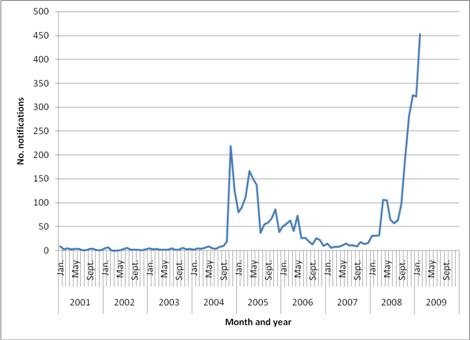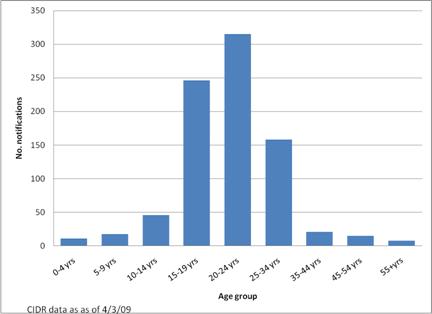Continued increase in mumps cases in 2009
The number of individuals affected by the mumps outbreak is increasing, with 843 cases notified to the Health Protection Surveillance Centre since the beginning of the year (as of 4/3/09); 453 cases were notified in February alone, the greatest number reported in any one month period since the outbreak began in 2004. (Figure 1)
Those most affected by mumps are between the ages of 15-24 years (66.5%). (Figure 2) Slightly more males (54.8%) than females have been reported. Information on hospitalization status was available on 330 cases, of whom 14 cases have been hospitalized (for orchitis and/or pancreatitis and unspecified reasons), all were male. Vaccination status was reported for 41% of all cases (n=336); of whom 25% were unvaccinated, 29% were incompletely vaccinated and 46% reported two doses of vaccine (complete vaccination).
Since the beginning of 2009, 16 new outbreaks have been reported, colleges/universities, and other educational facilities (school, crèche). These are in addition to already recognized community wide outbreaks reported in 2008 when 18 outbreaks were reported in university or third level colleges, seven school outbreaks were reported and one outbreak in a crèche. Workplace outbreaks were also reported in 2008.
The mumps outbreak in Ireland demonstrates similar characteristics to outbreaks reported in other developed countries; England, the United States, and Canada. All these countries have reported large mumps outbreaks in recent years, most notable in colleges and third level academic institutions. Outbreaks have been particularly common in those countries or areas with low MMR coverage, and are affecting students in age groups many of whom are incompletely vaccinated. Some outbreaks have been reported in highly vaccinated populations (United States) but the numbers are substantially less than that reported in countries with low immunization rates. In areas where outbreaks have occurred, and where targeted action has successfully improved MMR uptake, the outbreaks have been controlled. A combination of primary vaccine failure (failure to develop immunity after the vaccine) and waning immunity may both have a part to play in these outbreaks now being seen in developed countries.
Figure 1. Mumps notifications by month and year (01/2001-02/2009*)

CIDR: data downloaded 04/03/2009 at 16:45 hours. Provisional data for 2008/2009
Figure 2. Mumps notifications by age group (2009*)

Protecting against mumps
Mumps vaccination, available in the MMR vaccine is the best preventive method to prevent mumps and its associated complications. Recent studies published in international literature estimate that one dose of MMR is approximately 80% effective and estimates for two doses of MMR range from 88-95% effective in preventing mumps illness.
All individuals less than 25 years of age are recommended to ensure that they have had two doses of MMR. If they do not have vaccination records documenting two doses they are advised to seek MMR vaccination from their GP or other health provider (e.g. student health service for students). The MMR vaccine is free to this age group. Payment for the GP visit may be required for non medical card holders. Student health services are free.
Individuals older than 24 years are usually immune from mumps as a result of natural infection. However, if individuals in older age groups wish to receive MMR vaccine this can be obtained from the GP. There is no upper age limit to the MMR vaccine.
References
- Dayan GH, Quinlisk PM, Parker AA, Barskey AE, et al. Resurgence of Mumps in the United States. NEJM 2008 358(15); 1580-1589
- Rubin SA, Qi L, Audet SA, Sullivan B, Carbone KM, Bellini WJ, Rota PA, Sirota L, Beeler J. Antibody Induced by Immunization with the Jeryl Lynn Mumps Vaccine Strain Effectively Neutralizes a Heterologous Wild-Type Mumps Virus Associated with a Large Outbreak. The Journal of Infectious Diseases 2008; 198:508 –15
- Cohen C, White JM, Savage EJ, Glynn JR, Choi Y, Andrews N, et al. Vaccine effectiveness estimates, 2004–2005 mumps outbreak, England. Emerg Infect Dis [serial on the Internet]. 2007 Jan [date cited]. Available from http://www.cdc.gov/ncidod/EID/13/1/12.htm
- Mossong J, Bonert C, Weicherding P, Opp M, Reichert P, Even J, Schneider F. Mumps outbreak among the military in Luxembourg in 2008: epidemiology and evaluation of control measures. Euro Surveill. 2009;14(7):pii=19121. Available online: http://www.eurosurveillance.org/ViewArticle.aspx?ArticleId=19121


